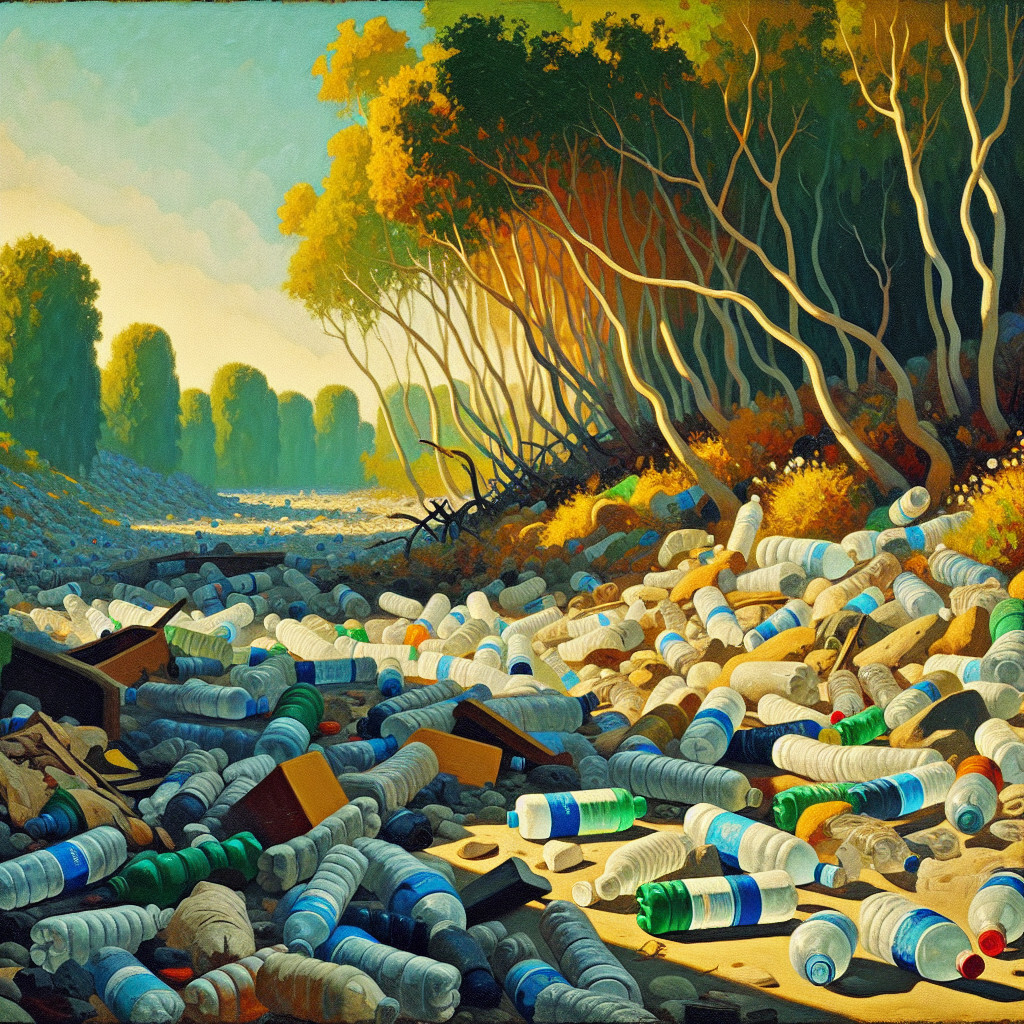-
Table of Contents
“Water Bottles: Convenience Today, Consequence Tomorrow.”
Introduction

The environmental impact of water bottles is a significant concern in the global discourse on sustainability. This issue revolves around the extensive use of plastic in the production of water bottles, leading to substantial waste generation and pollution. The manufacturing process also contributes to carbon emissions, while the disposal of these bottles often results in them ending up in landfills or oceans, causing harm to wildlife and ecosystems. Furthermore, the energy consumed in the production, transportation, and recycling of water bottles adds to their overall environmental footprint.
The Hidden Dangers of Plastic Water Bottles on Our Environment
The environmental impact of water bottles, particularly those made of plastic, is a topic of growing concern in our modern society. As the demand for convenience and portability continues to rise, so does the production and consumption of plastic water bottles. However, the hidden dangers of these seemingly harmless containers are far-reaching and pose a significant threat to our environment.
Plastic water bottles are made from a petroleum product known as polyethylene terephthalate (PET), which requires large amounts of fossil fuels to produce and transport. The Pacific Institute estimates that the production process for the bottled water consumed in the United States alone requires the equivalent of more than 17 million barrels of oil, not including the energy for transportation. This process also produces carbon dioxide, contributing to global warming.
Moreover, the manufacturing process of plastic water bottles generates a considerable amount of waste. According to the Container Recycling Institute, more than 60 million plastic bottles end up in landfills and incinerators every day. These bottles take up to 1,000 years to biodegrade, and when they finally start to decompose, they release toxic chemicals into the soil and groundwater.
In addition to the waste generated during production, the disposal of plastic water bottles also poses a significant environmental challenge. Despite the availability of recycling programs, the majority of plastic water bottles are not recycled. The Environmental Protection Agency estimates that only about 23% of plastic bottles are recycled in the U.S. The rest end up in landfills, or worse, as litter in our oceans and natural landscapes.
The impact of plastic water bottles on our oceans is particularly alarming. The National Oceanic and Atmospheric Administration reports that plastic debris kills an estimated 100,000 marine mammals annually, as well as millions of birds and fishes. The plastic that ends up in our oceans gradually breaks down into microplastics, tiny particles less than five millimeters in diameter. These microplastics are ingested by marine life, entering the food chain and ultimately ending up on our plates.
Furthermore, the production and consumption of bottled water also contribute to water scarcity. The Pacific Institute reports that for every liter of bottled water produced, three liters of water are used. This is particularly concerning in areas where water is scarce, and the production of bottled water is depleting local water supplies.
In conclusion, the environmental impact of water bottles is a multifaceted issue that requires urgent attention. The production and disposal of plastic water bottles contribute significantly to global warming, pollution, and water scarcity. As consumers, we can help mitigate these impacts by reducing our consumption of bottled water, opting for reusable bottles, and recycling whenever possible. As a society, we need to invest in sustainable alternatives to plastic and improve our waste management and recycling systems. The hidden dangers of plastic water bottles on our environment are too significant to ignore, and it is our collective responsibility to address this issue for the sake of our planet and future generations.
Understanding the Environmental Impact of Single-Use Water Bottles
Understanding the environmental impact of single-use water bottles is crucial in today’s world, where environmental sustainability is a pressing concern. The convenience of grabbing a bottle of water on the go is undeniable, but the environmental cost of this convenience is often overlooked.
Single-use water bottles are typically made from a type of plastic called polyethylene terephthalate (PET). While PET is recyclable, the sad reality is that a significant percentage of these bottles end up in landfills or, worse, in our oceans. According to the Container Recycling Institute, more than 60 million plastic bottles end up in landfills and incinerators every day. This is a staggering figure, especially considering that plastic takes hundreds of years to decompose.
Moreover, the production of these bottles also contributes to environmental degradation. The process of making PET involves the extraction and processing of crude oil and natural gas, both of which are non-renewable resources. The Pacific Institute estimates that the production process for bottled water requires around 17 million barrels of oil annually, which is enough to fuel 1.3 million cars for a year. This does not even take into account the energy required for bottling, packaging, and transporting the water.
Furthermore, the production of plastic bottles releases harmful emissions into the atmosphere. The burning of fossil fuels during the manufacturing process releases carbon dioxide, a greenhouse gas that contributes to global warming. Additionally, toxins are released during the production of plastic, which can contaminate air, soil, and water.
The environmental impact of single-use water bottles extends to our oceans as well. It is estimated that 8 million metric tons of plastic waste enter our oceans each year, posing a significant threat to marine life. Many marine animals mistake plastic for food, leading to fatal consequences. The plastic debris in the ocean also breaks down into microplastics, tiny particles that are ingested by marine life and can make their way up the food chain, potentially impacting human health.
The environmental impact of single-use water bottles is not limited to their production and disposal. The extraction of water for bottling can also have significant environmental consequences. In many cases, water is sourced from springs or groundwater, potentially depleting local water supplies. This can lead to water scarcity in certain regions, affecting both people and ecosystems.
In conclusion, the environmental impact of single-use water bottles is multifaceted, encompassing not only the waste generated by their disposal but also the resources consumed and the emissions produced during their manufacture. Moreover, the extraction of water for bottling can have significant local environmental impacts. As consumers, it is important to be aware of these impacts and to consider alternatives to single-use water bottles, such as reusable bottles or tap water, wherever possible. By making informed choices, we can contribute to reducing the environmental footprint of our hydration habits.
How Water Bottles Contribute to Global Pollution: A Deep Dive
Water bottles, a common sight in our daily lives, have become a symbol of convenience and health. However, beneath this seemingly harmless facade lies a significant contributor to global pollution. The environmental impact of water bottles is a topic that warrants a deep dive, as it is a pressing issue that affects us all.
The production of water bottles is a resource-intensive process that begins with the extraction of crude oil. It is estimated that the manufacturing of plastic bottles consumes millions of barrels of oil annually. This not only depletes our finite fossil fuel reserves but also contributes to air pollution due to the release of harmful emissions during the production process. Furthermore, the energy consumed in this process contributes to global warming, exacerbating the climate crisis.
Once produced, these bottles need to be filled with water, a process that also has significant environmental implications. The water used in bottled water is often sourced from natural springs, which can lead to water scarcity in the surrounding areas. Moreover, the energy required to pump, process, and transport this water adds to the overall carbon footprint of each bottle.
The environmental impact of water bottles does not end with their production and filling. Once consumed, these bottles often end up in landfills or, worse, in our oceans. Despite recycling initiatives, it is estimated that only a small fraction of plastic bottles are recycled, with the majority ending up as waste. This waste not only takes up valuable space in our landfills but also contributes to the pollution of our oceans. Plastic waste in the ocean is a significant threat to marine life, as animals can mistake it for food, leading to injury or death.
Moreover, plastic bottles take hundreds of years to decompose, during which they break down into smaller pieces known as microplastics. These microplastics are now ubiquitous in our environment, found even in the most remote corners of the earth. They pose a significant threat to both wildlife and humans, as they can enter the food chain and cause harm.
The environmental impact of water bottles is further exacerbated by the fact that they are often transported long distances before reaching the consumer. This transportation process consumes additional energy and contributes to air pollution and global warming.
In conclusion, the environmental impact of water bottles is a multifaceted issue that encompasses the depletion of natural resources, contribution to air and water pollution, and the generation of waste. It is a pressing issue that requires immediate attention and action. As consumers, we can play a part in mitigating this impact by reducing our consumption of bottled water, opting for reusable bottles, and supporting recycling initiatives. At the same time, it is crucial for policymakers and businesses to implement sustainable practices in the production, distribution, and disposal of water bottles. Only through collective action can we hope to mitigate the environmental impact of water bottles and move towards a more sustainable future.
The Role of Water Bottles in Oceanic Plastic Waste: An Unseen Crisis
The environmental impact of water bottles, particularly their role in oceanic plastic waste, is an unseen crisis that demands immediate attention. As the world grapples with the escalating problem of plastic pollution, the contribution of water bottles to this issue is often overlooked. This article aims to shed light on the magnitude of this problem and underscore the urgent need for sustainable solutions.
Water bottles, primarily those made of plastic, are a ubiquitous part of our daily lives. They are convenient, lightweight, and disposable, making them a popular choice for consumers worldwide. However, this convenience comes at a significant environmental cost. Every year, millions of these bottles end up in our oceans, contributing to the growing problem of plastic pollution.
The statistics are alarming. According to the Container Recycling Institute, more than 60 million plastic bottles end up in landfills and incinerators every day. A significant portion of these bottles also finds their way into our oceans. The Ellen MacArthur Foundation estimates that by 2050, there could be more plastic than fish in the world’s oceans if current trends continue.
The impact of these water bottles on marine life is devastating. Plastic bottles and their caps can take hundreds of years to decompose, during which time they break down into smaller pieces known as microplastics. These microplastics are often mistaken for food by marine animals, leading to ingestion and subsequent health problems. Moreover, larger pieces of plastic can entangle and harm marine creatures, disrupting their natural behaviors and habitats.
The environmental impact of water bottles extends beyond the oceans. The production of plastic bottles also contributes to climate change. According to the Pacific Institute, producing the plastic for the bottles used in the United States alone requires the equivalent of more than 17 million barrels of oil annually. This does not even include the energy used for transportation and refrigeration.
Furthermore, the extraction and use of water for bottling can have significant impacts on local water resources. In many cases, water is sourced from regions already facing water scarcity, exacerbating the problem. The bottling process also requires a significant amount of water, with the Pacific Institute estimating that for every liter of bottled water produced, an additional three liters of water are used.
Despite these alarming facts, the consumption of bottled water continues to rise. This trend is driven by a variety of factors, including perceived health benefits, convenience, and marketing efforts by bottled water companies. However, it is crucial to recognize the environmental cost of this convenience and to seek more sustainable alternatives.
One such alternative is the use of reusable water bottles. These bottles can be refilled and used multiple times, significantly reducing the amount of plastic waste generated. Additionally, tap water in many developed countries is safe to drink and undergoes rigorous testing to ensure its quality.
In conclusion, the environmental impact of water bottles, particularly their role in oceanic plastic waste, is a crisis that cannot be ignored. It is a problem that requires collective action, from individuals choosing reusable bottles over disposable ones, to governments implementing policies that promote sustainable practices. As consumers, we have the power to drive change through our choices. By opting for more sustainable alternatives, we can help mitigate the environmental impact of water bottles and contribute to a healthier planet.
Q&A
1. Question: What is the environmental impact of producing plastic water bottles?
Answer: The production of plastic water bottles requires a significant amount of energy and resources, including petroleum, which contributes to air pollution and climate change. It also generates waste during the manufacturing process.
2. Question: How does the disposal of water bottles affect the environment?
Answer: Improper disposal of water bottles can lead to litter and pollution in natural environments. Plastic bottles can take up to 1,000 years to decompose, releasing harmful chemicals into the soil and water. They also contribute to the massive plastic waste problem in the oceans, harming marine life.
3. Question: What is the impact of transporting bottled water on the environment?
Answer: Transporting bottled water over long distances involves burning fossil fuels, which contributes to air pollution and climate change. It also increases the carbon footprint of the bottled water.
4. Question: How can the environmental impact of water bottles be reduced?
Answer: The environmental impact of water bottles can be reduced by recycling, reusing, or opting for alternatives like reusable water bottles. Also, supporting policies and initiatives that promote clean tap water can help reduce the demand for bottled water.
Conclusion
The environmental impact of water bottles is significantly negative. They contribute to pollution, waste, and depletion of natural resources. The production process of water bottles uses large amounts of energy and water, while their disposal often leads to them ending up in landfills or oceans, causing harm to wildlife and ecosystems. Furthermore, the recycling rate of water bottles is low, exacerbating their environmental footprint. Therefore, reducing the use of bottled water and opting for sustainable alternatives is crucial for environmental conservation.






